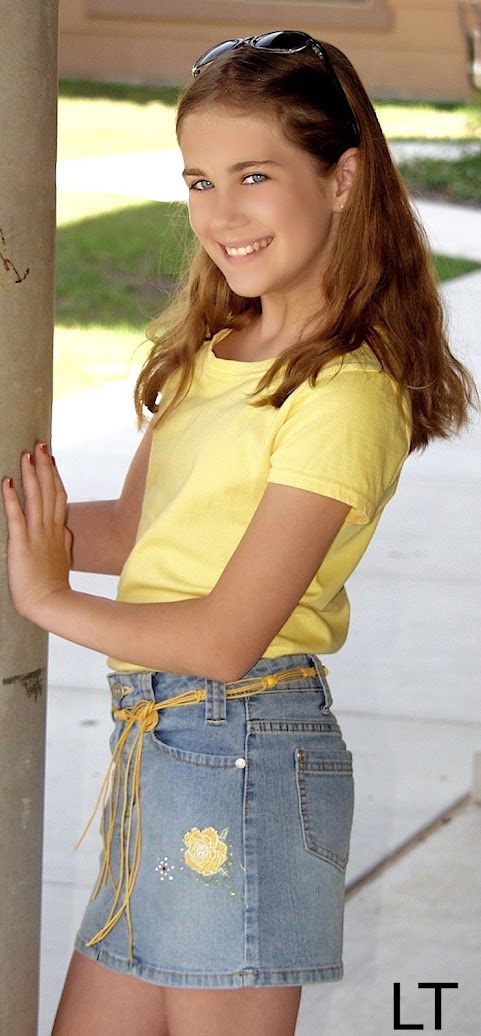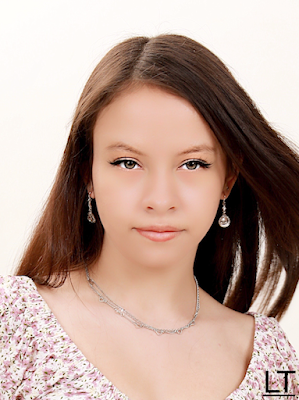 |
| Maria received two degrees (double major) from the University of Texas, both majors in 4 years: Communication Studies and Computer Science. Currently, she lives in France. |
Shoot photos that make the model stand out and look good.
I try to take photos that get attention, reminiscent of my children's black/white photography 40 years ago for SAG agents, TV Commercial managers, and talent/modeling agents, such as headshots, composites, and modeling portfolios.-----
Sharp Photos
When shooting outside, I shoot at 1/1000 second or faster with a sharp 85mm lens to keep images sharp for portraits and fashion. I set my camera to automatically adjust the shutter speed within the interval [1/1000, 1/8000], which allows the camera's computer to select the shutter speed to float in that interval. The camera also adjusts ISO. But, I set the aperture at f/2.8, or f/2.0, or even larger to isolate the model and blur the background. I also move close, filling the frame. Sometimes, if the image seems too dark, I adjust the exposure, perhaps +.3 EV. Also, I often use a Canon flash unit attached to the camera set to high speed as a fill to light the eyes.
-----
My System
Shoot photos that make the model stand out and look good.
- Watch background.
- Seek shade.
- Blur background.
- Come Close (Fill the frame).
- Focus on the eyes.
- Light the eyes.
Test Photographer (Children, Tweens, Teens, and Young Adults)
I often take more than 200 digital images in about two hours. The number of images often overwhelms parents and models when making selections. I have been willing to dump unprocessed photos onto a flash drive, so the parent and model can choose the images they want me to process, up to 6 images. But, most parents rely on my judgment. Also, parents can use the pictures I e-mail them to market the model, send to agencies for an online profile, e-mail to friends and relatives, post on Instagram or their personal website, Senior photos or have prints made, etc.
Note: I may discontinue putting hundreds of images on a thumb drive that a model or parent can take home. Parents and models can sit at my computer to select images for processing.
The model and I exchange services.
Light the eyes!
Some photographers say that the model should face the sun, which causes squinting. It is a terrible idea. Instead, place the model in the shade so that her back is to the sun, which means her face is on the shadow side and needs a fill that balances properly. Often, I use a Canon flash set to high speed attached to the camera when the location does not make a face light up.
See the photo below. It's not perfect, but it demonstrates how I approach shooting photos of young children. Pose the model in the shade with her back to the sun, and focus on the eyes! I have a sharp 85mm prime lens that I usually shoot at f/2.8 to blur the background. Note: In the photo below, I used f/4. Also, there was enough light reflected up from the concrete for fill. I came in close, so the camera metering nailed the scene correctly. I focused on the eyes.
The Charm of Youth! 😋
Get at eye level. Focus on the eyes. Get close, filling the frame. Shoot verticals. Avoid distracting backgrounds. Shoot in the shade. Keep the model's back to the sun and use a flash set to high speed as fill. Shoot at a wide aperture such as f/2.8, even f/4, to blur the background. Outdoors, try to shoot at a high shutter speed to keep the image sharp.
Images coming straight from the camera are okay but not great until processed. My minimal processing makes them better, not perfect. I'm not in business, and I do not photoshop photos or do makeup. Also, I am not a family portrait or wedding photographer. The digital images are huge files, so typically, I downsize them to 1000 pixels across. Parents usually let me select up to 5 or 10 of the best photos, process them, and email them, which takes about a week. Processing includes minor corrections, downsizing, cropping, sharpening. Gabby (below) does her own makeup. 8-8-21
 |
| Gabby, 16, Test Photoshoot Indoors Location: At my house July 23, 2021 |
 |
| Outdoor Portrait (Credit: Hannah) 11-09-2020 Eyes must glitter! |
Tips for young models.
After examining thousands of my images from the past 10 years, I noticed several trends that made the model stand out. First, try to stay away from black--you don't want to blend in the background; you want to stand out! Second, avoid busy patterns that distract from your face. Third, keep your hair off your face, which is your most important asset, i.e., being photogenic. To stand out, wear bright colors, not dark, dull colors. Pastels are great, too! Also, jeans, shorts, and tops should not be baggy or loose--the camera adds pounds! You don't want that. Additionally, long dresses don't work for today's youth. Kids want to look cute, so they go short! Trendy or not, avoid ripped jeans because the rips often sidetrack attention. When I look at a photo of a model in ripped jeans, I look at the rips, not the model's face or expression. Finally, young children should avoid makeup, hair coloring, and trendy hairstyles--long and straight hair works and is changeable. When you are a teen, you may need a tad of makeup.
Simple clothing styles are better. I look for shade, keep the sun to the model's back, and watch for light spills on the face. Busy patterns, bold stripes, and trendy styles can distract from the model, which is why I like solid colors, primary colors, pastels, and classic clothing styles. Outfits should complement, not dominate, the picture.
Eye contact with the camera is important, but so is a profile shot now and then. Outdoors, I often use an on-camera Canon flash unit set to high speed to light the eyes.
My Equipment is simple but expensive. I have one L lens and one camera.
- Canon's 85mm f/1.4 L. The 85mm is a prime lens. (I don't use zoom lenses.)
- Canon 5D Mark iv
Note: This page replaces my photography page.
Education Photos:
Graham, 6th Grade.

Clothing: I like solid colors, primarily white and pastel colors. But primary colors and other colors work well, too.
I am older, so it is not easy for me to hold the camera steady like I used to. (I never use a tripod.) On the Canon 5D Mark iv camera, I can set the shutter speed to auto between [1/1000 and 1/8000]. The ISO adjusts accordingly. When I use flash outdoors as a fill, the Canon flash (580EXII) is set to high speed. I have experimented with shooting at f/1.4 for a full length (Canon 85mm f/1.4 L), and, to my surprise, the photos were sharp.
 |
| Canon 5D Mark iv with the Canon 85mm f/1.4 L. 1/1250, f/2.8, ISO 320, AWB, EC +.333 Model: Gabby, flashing a smile. |
 |
| Kailey at about 12 as a middle school student. |
My Rule: Shoot photos that make the model stand out.
Some kids don't look good in pictures. I can't change that.











